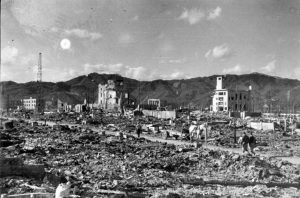Documenting Hiroshima of 1945: In December, Hiroshima tragedy recorded in order to memorialize mother and others
Dec. 26, 2024
by Maho Yamamoto, Staff Writer
In December 1945, Yuichiro Sasaki, a photographer from Hiroshima City who died in 1980 at the age of 63, photographed the ruins of the city center as well as the Hiroshima Prefectural Industrial Promotion Hall (present-day A-bomb Dome). Mr. Sasaki continued to record the devastation of the city to show the tragic consequences of the atomic bombing based on his desire to memorialize his mother and siblings who died in the bombing.
One of his photographs shows the Hiroshima Prefectural Industrial Promotion Hall and the building of the Hiroshima Prefectural Association of Commerce and Industry (present-day Hiroshima Chamber of Commerce and Industry) from behind passers-by on the burned-out Hondori shopping street. Another photo connecting with that scene shows the torii gate of the Hiroshima Gokoku Shrine. After the atomic bombing, Mr. Sasaki pointed his camera at locations where his family had lived, in Honkawa-cho (in the city’s present-day Naka Ward) and Teppo-cho (also in Naka Ward), as well as at schools, areas in front of Hiroshima Station, and collapsed private residences.
Mr. Sasaki worked for Nihon Shashin Kosha (Japan Photography Public Corporation) and was a photographer for a weekly bulletin called “The Weekly Photographic Bulletin,” published by the Cabinet Information Board. On August 6, he was in Tokyo but returned to Hiroshima on August 9 and observed the devastation caused by the bombing. There was no trace of his parent’s house, which had been located in the area known today as Nishi Tokaichi-machi (in the city’s present-day Naka Ward).
After returning to Tokyo for a short time, he traveled once again to Hiroshima on August 18, carrying with him his own camera and 10 rolls of film that he had received as severance pay from the dissolution of the public corporation. He desperately searched for his family, but 13 of them, including his mother, older and younger brothers, nephews, and nieces, had died in the bombing. “I took out my camera to record the places where my relatives had died, at least as a kind of memorial for them. But, before I knew it, I was taking photos of everything I saw,” a description he wrote in his collection of A-bomb photos published in 1977 titled Hiroshima wa Ikiteita (in English ‘Hiroshima had been alive’).
After the war, while running a photo studio, he continued to photograph A-bomb survivors as they suffered from their physical and psychological scars, as well as the city’s recovery. In particular, the A-bomb Dome, which he had seen since his childhood, became one his lifelong photographic subjects.
He hoped his photographs would serve as living witnesses to the atomic bombing. He wrote in his photo collection that, “No matter how many photos I take, I don’t think they are enough, and I am never satisfied.” Over the course of more than 30 years until his death, he took over 100,000 photos.
(Originally published on December 26, 2024)
In December 1945, Yuichiro Sasaki, a photographer from Hiroshima City who died in 1980 at the age of 63, photographed the ruins of the city center as well as the Hiroshima Prefectural Industrial Promotion Hall (present-day A-bomb Dome). Mr. Sasaki continued to record the devastation of the city to show the tragic consequences of the atomic bombing based on his desire to memorialize his mother and siblings who died in the bombing.
One of his photographs shows the Hiroshima Prefectural Industrial Promotion Hall and the building of the Hiroshima Prefectural Association of Commerce and Industry (present-day Hiroshima Chamber of Commerce and Industry) from behind passers-by on the burned-out Hondori shopping street. Another photo connecting with that scene shows the torii gate of the Hiroshima Gokoku Shrine. After the atomic bombing, Mr. Sasaki pointed his camera at locations where his family had lived, in Honkawa-cho (in the city’s present-day Naka Ward) and Teppo-cho (also in Naka Ward), as well as at schools, areas in front of Hiroshima Station, and collapsed private residences.
Mr. Sasaki worked for Nihon Shashin Kosha (Japan Photography Public Corporation) and was a photographer for a weekly bulletin called “The Weekly Photographic Bulletin,” published by the Cabinet Information Board. On August 6, he was in Tokyo but returned to Hiroshima on August 9 and observed the devastation caused by the bombing. There was no trace of his parent’s house, which had been located in the area known today as Nishi Tokaichi-machi (in the city’s present-day Naka Ward).
After returning to Tokyo for a short time, he traveled once again to Hiroshima on August 18, carrying with him his own camera and 10 rolls of film that he had received as severance pay from the dissolution of the public corporation. He desperately searched for his family, but 13 of them, including his mother, older and younger brothers, nephews, and nieces, had died in the bombing. “I took out my camera to record the places where my relatives had died, at least as a kind of memorial for them. But, before I knew it, I was taking photos of everything I saw,” a description he wrote in his collection of A-bomb photos published in 1977 titled Hiroshima wa Ikiteita (in English ‘Hiroshima had been alive’).
After the war, while running a photo studio, he continued to photograph A-bomb survivors as they suffered from their physical and psychological scars, as well as the city’s recovery. In particular, the A-bomb Dome, which he had seen since his childhood, became one his lifelong photographic subjects.
He hoped his photographs would serve as living witnesses to the atomic bombing. He wrote in his photo collection that, “No matter how many photos I take, I don’t think they are enough, and I am never satisfied.” Over the course of more than 30 years until his death, he took over 100,000 photos.
(Originally published on December 26, 2024)








